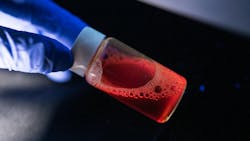Researchers at Rice University, Houston, have developed a new method for performing chemical reactions using water instead of toxic solvents, providing a safer, greener alternative for many chemical processes.
The new micellar technology represents a step forward in sustainable chemistry, drastically reducing pollution in industries such as pharmaceuticals and materials science, where harmful organic solvents are often necessary, said Rice in a press statement.
The scientists designed metal complex surfactants (MeCSs) that self-assemble into nanoscale spheres called micelles, creating microscopic reactors capable of driving light-powered reactions.
The self-assembled micelles form in water, where their hydrophobic cores provide a unique environment for reactions, even with materials that are typically insoluble in water. The research team led by Angel Martí, professor and chair of chemistry at Rice, demonstrated this system can efficiently perform photocatalytic reactions while eliminating the need for hazardous substances.
As part of their findings reported in Chemical Science, the researchers tested different versions of the MeCSs by altering the length of their hydrophobic, or water-repelling, tails. They found the molecules could form micelles as small as 5-6 nanometers, much smaller than those in similar systems. When used to perform a photocatalytic reaction, the micelles achieved high yields without needing harmful solvents.
The system also can be reused, improving its cost-effectiveness and environmental footprint, said Rice.
About the Author
Amanda Joshi
Managing Editor
Amanda Joshi has more than 18 years of experience in business-to-business publishing for both print and digital content. Before joining Chemical Processing, she worked with Manufacturing.net and Electrical Contracting Products. She’s a versatile, award-winning editor with experience in writing and editing technical content, executing marketing strategy, developing new products, attending industry events and developing customer relationships.
Amanda graduated from Northern Illinois University in 2001 with a B.A. in English and has been an English teacher. She lives in the Chicago suburbs with her husband and daughter, and their mini Aussiedoodle, Riley. In her rare spare time, she enjoys reading, tackling DIY projects, and horseback riding.

